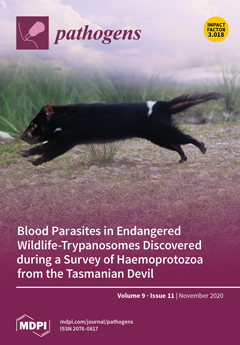Ducks are a natural reservoir of influenza A viruses (IAVs) and can act as a reassortment vessel. Wetlands, such as Hakaluki and Tanguar haor in Bangladesh, have unique ecosystems including domestic duck (
Anas platyrhynchos domesticus) rearing, especially household and free-range ducks.
[...] Read more.
Ducks are a natural reservoir of influenza A viruses (IAVs) and can act as a reassortment vessel. Wetlands, such as Hakaluki and Tanguar haor in Bangladesh, have unique ecosystems including domestic duck (
Anas platyrhynchos domesticus) rearing, especially household and free-range ducks. A cross-sectional study was, therefore, conducted to explore avian influenza status and its distribution and risk factors in the wetland areas. During the three consecutive winters of 2015–2017, specifically in December of these years, we collected a total of 947 samples including blood, oropharyngeal and cloacal swabs from domestic ducks (such as free-range ducks (
n = 312 samples) and household ducks (
n = 635 samples) in wetlands. We screened serum samples using a nucleoprotein competitive enzyme-linked immunosorbent assay (c-ELISA) to estimate seroprevalence of IAV antibodies and swab samples by real-time reverse transcriptase polymerase chain reaction (rRT-PCR) to detect IA viral M gene. Eleven M gene positive samples were subjected to sequencing and phylogenetic analysis. Serological and viral prevalence rates of IAVs were 63.8% (95% CI: 60.6–66.8) and 10.7% (8.8–12.8), respectively. Serological and viral RNA prevalence rates were 51.8% (95% CI: 47.2–56.4) and 10.2% (7.6–13.3) in Hakaluki haor, 75.6% (71.5–79.4) and 11.1% (8.5–14.3) in Tanguar haor, 66.3% (62.5–69.9) and 11.2% (8.8–13.9) in household ducks and 58.7% (52.9–64.2) and 9.6% (6.5–13.4) in free-range ducks, respectively. The risk factors identified for higher odds of AI seropositive ducks were location (OR = 2.9, 95% CI: 2.2–3.8,
p < 0.001; Tanguar haor vs. Hakaluki haor), duck-rearing system (OR = 1.4, 1.1–1.8, household vs. free-range), farmer’s education status (OR = 1.5, 1.2–2.0,
p < 0.05 illiterate vs. literate) and contact type (OR = 3.0, 2.1–4.3,
p < 0.001; contact with chicken vs. no contact with chicken). The risk factors identified for higher odds of AI viral RNA positive ducks were farmer’s education status (OR = 1.5, 1.0–2.3,
p < 0.05 for illiterate vs literate), contact type (OR = 2.7, 1.7–4.2,
p < 0.001; ducks having contact with chicken vs. ducks having contact with waterfowl). The phylogenetic analysis of 11 partial M gene sequences suggested that the M gene sequences detected in free-range duck were very similar to each other and were closely related to the M gene sequences of previously reported highly pathogenic avian influenza (HPAI) and low pathogenic avian influenza (LPAI) subtypes in waterfowl in Bangladesh and Southeast Asian countries. Results of the current study will help provide significant information for future surveillance programs and model IAV infection to predict the spread of the viruses among migratory waterfowl, free-range ducks and domestic poultry in Bangladesh.
Full article






